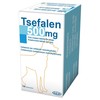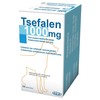Tsefalen
Tsefalen Tablets are for the treatment of infections of the respiratory system, urogenital system and skin, localised infections in soft tissue, and gastrointestinal infections caused by cefalexin-sensitive bacteria. They are non-flavoured tablets and will therefore not interfere with food trails or cause a reaction in food sensitive dogs.
Tsefalen Tablets are oblong film-coated tablets that are orange in colour with a break-line on one side. They can be divided into two equal parts for easy and accurate dosing.
Tsefalen 500mg Tablet for Dogs
£0.58Tsefalen 500mg Tablets are indicated for the treatment of infections of the respiratory system, urogenital system and skin, localised infections in soft tissue, and gastrointestinal...[More info]
Tsefalen 1000mg Tablet for Dogs
£1.06Tsefalen 1000mg Tablets are indicated for the treatment of infections of the respiratory system, urogenital system and skin, localised infections in soft tissue, and gastrointestinal...[More info]
Contraindications
Do not use in cases of known hypersensitivity to the active substance, to other cephalosporins, to other substances of the B-lactam group or to any of the excipients.
Do not use in rabbits, gerbils, guinea pigs and hamsters.
Special warnings for each target species
None.
Special precautions for use in animals
Wherever possible, use of the product should be based on susceptibility testing of the bacteria isolated from the animal and take into account official and local antimicrobial policies.
Deviating from the instructions given in the SPC when using the product may increase the prevalence of bacteria resistant to cefalexin and may also decrease the effectiveness of other beta-lactam antimicrobial treatments, due to the potential for cross-resistance. Therefore , deviation from the instructions must only be undertaken according to a risk/benefit assessment by the responsible veterinarian.
Do not administer in cases of known resistance to cephalosporin and penicillin.
As with other antibiotics which are excreted mainly by the kidneys, systemic accumulation may occur when renal function is impaired. In case of known renal insufficiency the dose should be reduced, and antimicrobials known to be nephrotoxic should not be administered concurrently.
Special precautions to be taken by the person administering the veterinary medicinal product to animals
Penicillin's and cephalosporins may cause sensitisation (allergy) following injection, inhalation, ingestion, or skin contact. Sensitivity to penicillins may lead to cross sensitivity to cephalosporins and vice versa. Allergic reactions to these substances may occasionally be serious. Do not handle this veterinary medicinal product if you know you are sensitised or if you have been advised not to be in contact with such substances.
Handle this veterinary medicinal product with great care to avoid exposure, taking all recommended precautions. If you develop symptoms following exposure such as skin rash, you should seek medical advice and show the doctor this warning. Swelling of the face, lips or eyes or difficulty breathing are more serious symptoms and require urgent medical attention.
In case of accidental ingestion, seek medical advice immediately and show the package leaflet or the label to the physician.
Wash hands after use.
Adverse reactions (frequency and seriousness)
In very rare cases, nausea, vomiting or diarrhoea may occur following administration of the product.
In rare cases hypersensitivity can occur. In cases of hypersensitivity reactions the treatment should be discontinued.
The frequency of adverse reactions is defined using the following convention:
- very common (more than 1 in 10 animals treated displaying adverse reaction(s))
- common (more than 1 but less than 10 animals in 100 animals treated)~
- uncommon (more than 1 but less than 10 animals in 1,000 animals treated)
- rare (more than 1 but less than 10 animals in 10,000 animals treated)
- very rare (less than 1 animal in 10,000 animals treated, including isolated reports).
Use during pregnancy and lactation
Laboratory studies in rats and mice have not produced any evidence of teratogenic, foetotoxic, or maternotoxic effects.
The safety of the veterinary medicinal product has not been established during pregnancy and lactation. Use only accordingly to the benefit/risk assessment by the responsible veterinarian.
Interaction with other medicinal products and other forms of interaction
In order to ensure efficacy, the veterinary medicinal product should not be used in combination with bacteriostatic antibiotics.
Concurrent use of first generation cephalosporins with polypeptide antibiotics, aminoglycosides or some diuretics such as furosemide can enhance nephrotoxicity risks.
Amounts to be administered and administration route
Oral use.
The recommended dose is 15 mg of cefalexin per kg of body weight twice a day (i.e. equivalent to 1 tablet twice a day for a dog weighing 33 kg). In severe or acute conditions the dose may be doubled to 30 mg/kg twice daily.
Any increase in dose or duration of treatment should be accordingly to a benefit/risk assessment by the responsible veterinarian (e.g. chronic pyoderma).
To ensure a correct dosage body weight should be determined as accurately as possible to avoid underdosing.
The veterinary medicinal product can be given as whole tablets, or crushed and added to food if necessary.
Overdose (symptoms, emergency procedures, antidotes), if necessary
Concerning acute toxicity, an LD50 > 0.5 g/kg has been recorded following oral administration in dogs. The administration of cefalexin has been shown to produce no serious side effects at several times the recommended dose rate.
Withdrawal period
Not applicable.


